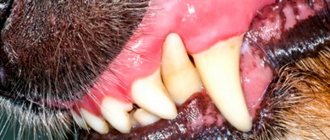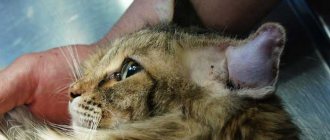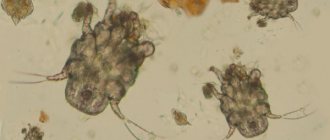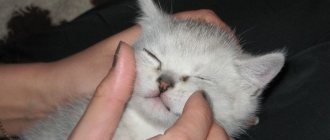If a dog has fluid flowing from its ear, but bends its head in this direction, tries to carefully scratch the outer ear with its back paw or, conversely, strongly, then you can safely make a diagnosis of otitis media. The veterinarian will have to find out what kind of inflammation the pet has, in which part of the ear canal it is localized, and only then choose treatment.
Regardless of what caused the otitis and where it develops, the animal is in pain and may develop symptoms:
- refusal to eat;
- reluctance to move;
- loss of balance;
- temperature increase.
The auricle with otitis media is inflamed and has a pronounced red color. It may ooze a brown or yellow-white foul-smelling mass. An unpleasant odor is often associated. Even to a person far from veterinary medicine, it is obvious that it is impossible to delay treatment. Damage to the inner ear is fraught with the development of infection and death of the animal from bacteria entering the brain.
Causes
The range of causes causing otitis media is wide. The most common one is cold. For mongrels and large breed dogs with long hair, sub-zero temperatures will not cause harm. But delicate and miniature breeds can get sick from walking on a cool, windy autumn day.
Hypothermia from air conditioning or drafts can occur in any dog. Such otitis media begins with the animal being restless, but there is no discharge from the ear. They will appear in a few days and will not be abundant. The inflammatory fluid has almost no odor.
Ear mites can also cause otitis media. In this case, the dog has a leak from the ear, or rather a brown viscous mass is released. Typically, ear mites infect two ear canals at once, but there are exceptions.
Fungal and staphylococcal otitis media appear due to the proliferation of infection inside the ear canal. This is facilitated by reduced immunity, a painful condition or prolonged use of antibiotics. In both cases the discharge from the ear is small but offensive. Its color ranges from white to light brown.
Symptoms of otitis media in dogs
If your dog reacts painfully to the touch of hands in the head and ears, and also constantly shakes its head, these may be the first signs of otitis media. For a better understanding of the disease, let’s look at the symptoms of otitis media in dogs in more detail.
Otitis in a dog photo.
Symptoms of otitis media:
- purulent and bloody discharge from the ears;
- unpleasant odor;
- redness of the skin in the inner part of the ear;
- in severe cases, inflammation of the submandibular lymph nodes;
- pain when yawning widely;
- periodic deafness;
- heaviness when eating solid foods;
- discharge from the eyes;
- in case of complications, meningitis and inflammation of the vestibular apparatus are observed.
Signs of dangerous diseases
Otitis media is dangerous in itself due to the proximity of inflammation to the brain. The owner should be especially careful if, with the appearance of otitis media, the pet sometimes or constantly experiences an inadequate condition.
Warning signs:
- walking in circles;
- epilepsy;
- lack of response to the owner’s voice;
- standing with your face to the wall;
- partial or complete loss of vision.
In this case, otitis is a consequence of a tumor and such an animal is unlikely to be able to alleviate the condition.
EAR INFECTIONS IN DOGS
views
Based on publications: G. Machikote Goth, “Diseases of the external ear of dogs and cats” // Veterinary Focus: 21.3, p. 2; A. M. Cordero, “Ear infections: what the owner needs to know” // Veterinary Focus: 25.2, p. 47.
Do you regularly clean your dog's ears to prevent infection? How exactly do you clean it? What symptoms make you decide it’s time to see a doctor? Do you know about systemic diseases, one of the manifestations of which can be otitis media? The minimum set of information about ear health in dogs is in our article...
The most important
First of all, ear disease in a dog always requires urgent consultation with a doctor.
. In some cases, it is easy to identify the cause of the disease and prescribe treatment, but this is not always the case.
The causes of otitis in dogs are very diverse.
and can affect the entire body.
There are diseases that, without treatment, lead to very serious consequences.
– in particular, to hearing loss, neurological disorders, irreversible changes in the structure of the auditory canal, requiring its surgical removal.
If any signs of inflammation are detected, you should immediately show the dog to a veterinarian.
Ear hygiene for a healthy dog
Don't forget to check regularly
Check the dog's ears for
redness, swelling, unusual or excessive discharge, mites, or foreign bodies.
The cause of inflammation can be seeds or plant stems that get into the ear during a walk or competition.
Normally, the ear glands produce sulfur secretion, which has antibacterial and antifungal properties, thereby maintaining the balance of microflora in the ear.
The layers of epithelial cells lining the ear canal synchronously move to the outer part of the ear as they grow and age, due to which wax secretion is also removed from the ear to the outside.
In this way, the healthy ear cleans itself. Sometimes you can “help” him a little: drop a little special lotion into the ear for cleaning dogs’ ears, following the manufacturer’s instructions. The dog is held in place for some time, massaging the area around the ear so that the lotion has time to work and soften the discharge. When you release the dog, he will most likely shake himself off and shake his head. The discharge that ends up on the skin and fur can be removed with a cotton pad or gauze swab.
It is advisable to consult your veterinarian about the need for other measures. If your dog needs a deeper ear cleaning or trimming of thick ear fur that is blocking wax removal, your dog's veterinarian will explain how to perform these procedures so that they are beneficial rather than harmful.
Causes of otitis media in dogs
The ear self-cleaning mechanism described above may be disrupted for a number of reasons, including due to swelling during inflammatory processes. A vicious circle arises: wax is not removed from the ear properly, the ear canal becomes clogged, the balance of microorganisms in it is disrupted, and the animal’s condition worsens.
If the inflammation becomes chronic, it can lead to ossification (calcification) of the ear canal and cartilaginous elements of the ear.
The development of inflammation can be promoted not only by external causes (water getting into the ear, a general infectious disease)
, but also
the body characteristics
of a particular dog:
- the presence of congenital narrowings (stenosis) and pronounced bends of the auditory canal;
- excess secretory glands
or their overactive work (too much sulfur is formed); - excessive growth of hair in the ears
, making it difficult to remove wax; - development of neoplasms
(tumors, cysts); - the presence of predisposing systemic diseases
(atopic dermatitis, allergies, primary seborrhea, hypothyroidism).
floppy ears are also at risk
and dogs that
frequently swim in water
(but a constantly wet environment conducive to the proliferation of microorganisms can occur not only during swimming, but also, for example, with frequent or prolonged use of lotions or drops).
Cases of breed predisposition have been described (for example, secretory inflammation of the middle ear in Cavalier King Charles Spaniels
or
otitis of German shepherds
, caused by congenital
narrowing of the horizontal part of the auditory canal)
.
In dogs for which the standard requires plucking (trimming) of hair growing in the ears, otitis media sometimes has an associated traumatic origin.
. On the other hand, thick hair growing in the ears needs to be trimmed if it interferes with normal ear function.
Otitis in dogs is one of the common symptoms of food allergies and intolerances.
. Up to 80% (!) of dogs with allergies and intolerances exhibit this symptom, and in 20-25% otitis media becomes the only sign of these conditions.
Certain types of parasitic infestations also lead to otitis media (primarily otodectosis
).
In general, approximately 20% of dogs experience inflammatory ear diseases for one reason or another.
Symptoms of ear diseases
The ear is a complex organ responsible not only for the perception of sounds, but also for the sense of balance and the position of the body in space. Ear diseases can affect not only the external, but also the deep parts of this organ. The doctor examines the ear using special equipment, but the owner can rely on the alarming symptoms listed below to decide whether to see a doctor.
Signs of inflammation of the outer ear
- The dog shakes its head
- Signs of pain, scratching and other mechanical damage to ear tissue
- Dermatitis (skin rashes) on the sides of the head and muzzle
- Redness, swelling
- Unpleasant odor from the ears
- Having heavy or unusual discharge from the ears
- Bonding of fur in the ears by secretions, formation of crusts
- Ear hematoma
Signs of inflammation of the middle ear
- The same symptoms as inflammation of the outer ear (the dog shakes its head, shows signs of pain; lethargy, drowsiness, unpleasant odor)
- Steady tilt of the head to one side (if the vestibular system is affected)
- Facial palsy (drooping eyelid; when the skin in the inner corner of the eye is touched, the dog is unable to close the eye completely)
- Constriction of the pupil, retraction of the eyeball, protrusion of the third eyelid (Horner's syndrome)
Signs of inflammation of the inner ear (impaired balance mechanisms, involvement of the nervous system)
- Shaking your head
- Ataxia (awkward, uncoordinated, asymmetrical movements with wide limbs)
- Walking in circles or falling frequently
- Very frequent rhythmic eye movements (nystagmus)
- Vomiting (in the acute stage of otitis media)
The symptoms listed here may have other causes, but they are still serious. Any of them should be the reason for a trip to the clinic.
Treatment and hygiene of ears for otitis media
With otitis media, the doctor’s task is not just to alleviate the animal’s suffering associated specifically with ear pain, but to identify and eliminate the primary cause of the symptoms. Without this, the treatment will not have a lasting effect.
If the root cause of the disease is, for example, a food allergy, then diagnosis and treatment can take a long time.
The inflammation caused by the primary cause often entails the development of secondary infections in the ear canal - bacterial (in particular, staphylococcal) and/or fungal (in particular, caused by Malassezia).
Thus, treatment of otitis often requires complex measures, which may include the prescription of antibacterial, antifungal, antiparasitic, anti-inflammatory drugs (primarily local ones).
The owner is required to carefully follow the doctor's instructions and regularly carry out the procedures recommended by him.
If we are talking about food allergies or intolerance to certain food components, significant changes may be necessary in the life of the owner’s entire family, due to the fact that the dog can now receive only certain food, without the usual treats and deviations from the therapeutic diet.
If the disease is associated with the presence of copious discharge from the ears, most likely they will need to be removed regularly. The doctor will show you exactly how to do this.
Therefore, the best thing we can do to maintain healthy ears in dogs is to regularly examine animals for unusual symptoms, keeping in mind that signs of ear infections may not be limited to the pinna area. It is also important to evaluate the condition of the eyes and skin, the animal’s motor activity, and the appearance of any other changes in its condition.
If signs of the disease develop, you should consult a doctor as soon as possible.
Share
Treatment
Beginning treatment for otitis is complicated by the fact that the animal experiences severe pain and can hit its teeth or bite the owner. Therefore, it is better if the first treatment is carried out by a veterinarian. In some cases, you have to use sedatives.
Folk remedies
Folk remedies that people use for ear pain are not suitable for animals. Chamomile decoction can be added to the diet as a systemic anti-inflammatory agent. There is no need to pour or place anything into the ear canal. Moreover, you can’t heat it.
Ready-made products
Choose medications for the treatment of otitis media based on the cause. If the dog's condition allows, the veterinarian will take fluid secreted from the ear for examination. It is important to study its composition, and when identifying bacteria, determine their sensitivity to standard antibiotics.
Types of diseases
Most often, if a dog's ears are squishing, this is not a sign of a life-threatening disease. You need to pay attention to the symptoms. Since any of the signs of the disease has its own characteristics that indicate the cause of the disease. In order to cure the pathology, you should know the form of the disease. It happens:
- Allergic.
- Bacterial.
- Fungal.
Injuries
If your dog develops ear pain from an injury, it should be seen by a veterinarian. It will help distinguish the injury from an insect bite. When a pet has a hematoma, the owner must apply a pressure bandage that will help stop the bleeding.
In some cases, it is left for 3-4 days. If an extensive hematoma has formed due to injury, it may be necessary to open it and remove blood clots. If there is damage to a large area, stitches are applied, the ear is wrapped and fixed. After 10 days, the sutures are removed.
Ear mite
If your pet shows anxiety and tries to scratch its ears, then perhaps the reason lies in a tick. This disease differs from otitis media in that in this situation both ears are affected. When otitis media develops, the dog's disease manifests itself predominantly on one side. Ear mites are manifested by dark-colored discharge in the form of crusts on the surface of the auricle. Discharge from the organ of hearing has a thick consistency. Then, as with otitis - liquid.
In order to make a correct diagnosis, the veterinarian recommends taking a scraping. Before obtaining the result, in order to alleviate the dog’s condition, you should clean the ear with Furacilin solution. To make it you need to dissolve 1 tablet in 250 ml. warm water. Soak a cotton swab in the resulting solution and clean the affected area. Use cotton swabs to clean the crust in hard-to-reach areas.
For your information, it is prohibited to penetrate deep into the ear canal while cleaning with cotton wool.
After receiving the scraping results, the veterinarian prescribes acaricides. They have three forms of release: ointment, drops and aerosol. The most used drugs include:
- Leopard;
- From one;
- Epi-otic;
- Otoferonol.
All products affect only fully mature individuals. In order to get maximum results, it is necessary to carry out the treatment twice with a 10-day interval. During this time, the larvae will degenerate into adult ticks. Additional treatment will be required to avoid re-infection. Acaricides should be applied according to the following rules:
- Before applying the drug, it must be warmed to room temperature. To do this, you need to hold the bottle in your hands for 5 minutes. Using a cold product can put your dog into shock.
- The medication should be applied with gentle movements inside the ear.
- Next, you should squeeze the ear along the longitudinal line and massage it without causing pain to the pet. This is necessary for uniform distribution of the medicine.
- In order to be sure that the parasites are completely killed, repeated treatment should be carried out.
Otitis
If a dog has purulent discharge accompanied by an unpleasant odor, this indicates the appearance of otitis media. It is also characterized by the appearance of plaque in the ears. It is easily treated with antibiotic therapy. Therapy for this disease is carried out as follows:
- remove crusts using a cotton swab treated with hydrogen peroxide;
- moisten the ear surface with Chlorhexidine;
- lubricate the internal cavity with Bepanten;
- drip 4 drops of Sofradex.
Labyrinthitis
When the inflammatory process affects the middle ear, labyrinthitis develops. It differs from otitis media in that fluid does not leak from the dog's ear. To eliminate the disease, the following treatment is prescribed, which lasts for a month:
- penicillin antibiotics;
- to reduce dizziness Alfaserc;
- Dicloran to relieve inflammation;
- Bonin as an antiemetic.
All medications are given twice. The dosage is selected individually, based on the dog’s weight.
Prevention
Prevention of otitis is based on three points:
- preventing water from entering;
- constant care of the auricle;
- absence of foods in the diet that can cause allergies.
From puppyhood, dogs need to be taught to manipulate their ears. The canal is cleaned using a cotton swab, immersing it to a maximum of 0.5 cm, or a cotton pad for large breeds. Ear hygiene lotion can be used as a softening composition. Peroxide or soap composition are not suitable. If the owner checks the dog's ears regularly, approximately once every 10-14 days, then he will notice the first signs of the disease. At this stage, treating otitis media is not difficult.
In an advanced state, otitis media is dangerous and will require more time to treat. In addition, the development of infection can lead to rupture of the eardrum and chronic ear disease.
How you can help your pet at home
Have you discovered that your dog has a red ear inside, how to treat it and how to help at home? The first and simplest home remedy for otitis media is cleaning the ear itself. It is important to carry out cleaning carefully. Avoid deep penetration into the auricle to avoid damage to the eardrum. Use cotton swabs; for small breeds you can use cotton swabs. You can massage your ear before cleaning. Use hydrogen peroxide (can be diluted if necessary), chlorhexidine, etc. For acute pain, you can give your dog painkillers such as Solpadeine, Ibuprofen or simple Analgin. The doctor will prescribe a more in-depth treatment, but if you have the appropriate skills, you can do novocaine blockades yourself.











